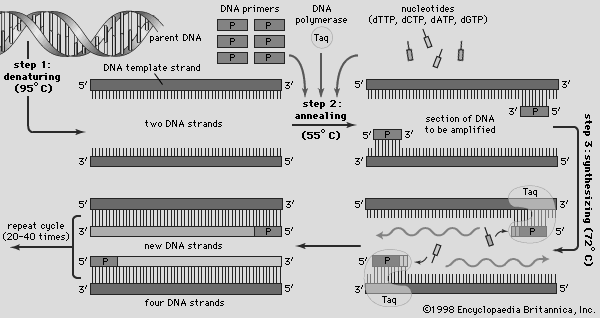BME100 f2014:Group32 L4
| Home People Lab Write-Up 1 | Lab Write-Up 2 | Lab Write-Up 3 Lab Write-Up 4 | Lab Write-Up 5 | Lab Write-Up 6 Course Logistics For Instructors Photos Wiki Editing Help | ||||||||||||||||||||||||||||||||||
|
OUR TEAM
LAB 4 WRITE-UPProtocolMaterials
PCR Reaction Sample List
Research and DevelopmentPCR - The Underlying Technology PCR Components PCR requires 4 key components: Template DNA, Primers, Taq Polymerase, and Deoxyribonucleotides (dNTPs). The template DNA serves as the base of the PRR reaction upon which we attach the primers, duplicate the DNA and use for the PCR reaction to amplify a section of. The primers are short sequences of nucleotides that attach to the template DNA sequence strand in the process of PCR and allow only the length of the primer strand to eventually be amplified in the reaction. Taq polymerase is a heat stable version of DNA polymerase that activates and operates in moderate to high temperature situations. The Taq polymerase finds deoxyribonucleotides in solution and attaches them to the actual DNA strand for duplication. These are the building blocks from which new DNA strands are synthesized.
The first step is the Initial Step: 95°C for 3 mins. In this step, the template DNA denatures and the two strands separate from each other. The primers and the dNTPs remain in solution without doing anything and are unaffected by this step. The Taq Polymerase is held at this temperature in order to be heat activated due to their high heat operating temperatures. The next step is denaturation at 95°C for 30 seconds. In this step the Template DNA is denatured at this point by disrupting the hydrogen bonds between the nucleotides and it yields single stranded DNA sequences. The third step is annealing at 57°C for 30 seconds. In this step the temperate is lowered to this in order to have the primers bond to the DNA template. It is not lowered to normal body temperature or below in order to allow a higher likely hood of shorter DNA strands binding to the longer DNA strand rather than themselves or the longer DNA strand annealing to itself once more. The primers bond and start to form hydrogen bonds with the template single stranded DNA strands. The fourth step is extension at 72°C for 30 seconds. This step is to elongate the DNA-primer bonded sequences in both directions. Taq polymerase has an optimally activity operating level of around 72 Degrees. The template strand and the primer is duplicated in this step over and over until after several iterations of this there will only be the spot singled out by the primers. The dNTPs are used as the building blocks of the amplified DNA strands that the Taq polymerase uses to build the newly duplicated and amplified DNA strands on top of the template strands, primer strands and single sequence amplification spot strands. The final step is an extension at 72°C for 3 mins. This step is used to make sure that all of the single stranded DNA is fully extended in any direction and that all strands in solution are amplified by the Taq Polymerase. And the last part is a hold at 4°C indefinitely in order to allow the reaction to remain stable and to have all products kept alive for short-term storage.
DNA is made up of four molecules: A for Adenine, T for Thymine, C for Cytosine, and G for Guanine. Base pairing is driven by hydrogen-bonding and the bases that pair with one another are Adenine (A) and Thymine (T), and Cytosine (C) and Guanine (G). Base-pairing occurs during the annealing step of the PCR thermal cycling – the primers anneal to the single strand of the template DNA strands and base-pairing occurs between those steps as well. DNA-DNA hydrogen bonds are formed between the primers and the template DNA sequences. Base-pairing also occurs during the extension step; the Taq Polymerase elongates the DNA-primer bonded DNA strands in both directions and uses the dNTPs in solution as the building blocks of the newly amplified strand, thus base-pairing is occurring in both directions through the elongate of the primer strand and the template DNA strand with an origin of replication located at the back end of the primer strand. The Final Step also includes minimal base-pairing or the possibility of base pairing because this step is to ensure that all DNA strands are fully extended in all directions; this is the last step that is using the dNTPs to build newly amplified strands of DNA.
| ||||||||||||||||||||||||||||||||||






